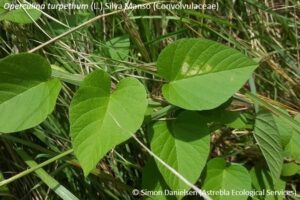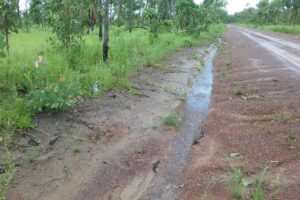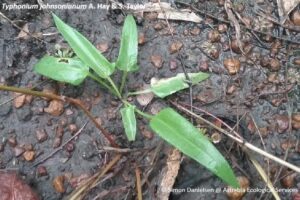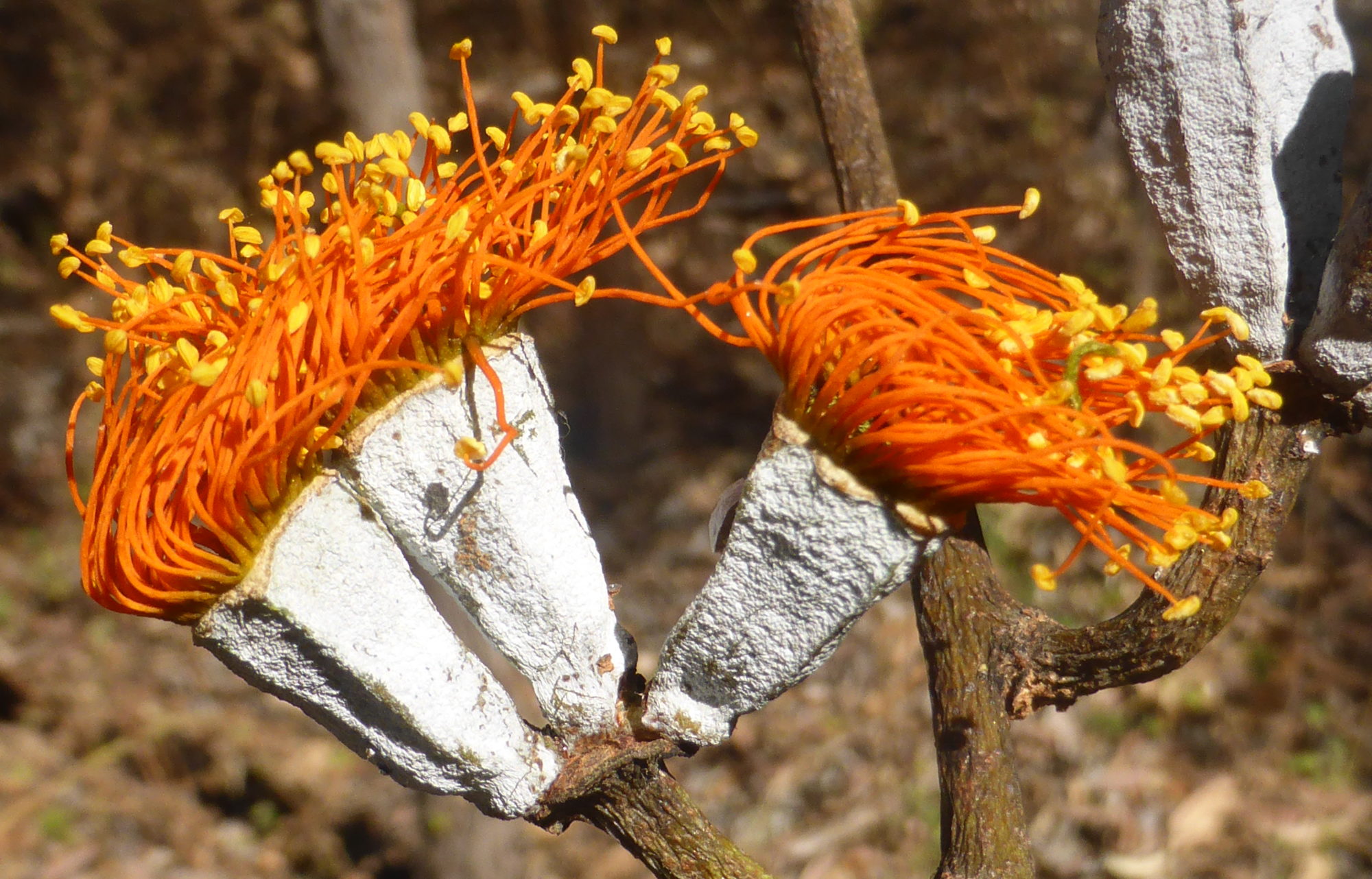In February 2018, I undertook a targeted survey with taxonomist Bob Harwood for the vulnerable geophyte Typhonium praetermissum on the Gunn Point peninsula, approximately 30 km north east of the Darwin CBD. In addition, we also searched for the vine Operculina turpethum. And we found both of them!
Operculina turpethum (L.) Silva Manso (Convolvulaceae)

Operculina turpethum is a twining vine growing to 4 m or more, recorded from various locations (mostly coastal and sub-coastal) across northern Australia, but primarily it is known from South East Asia. It had been recorded in 2000 from grassland at the rear of a low sand dune at Gunn Point, and our task was to determine if it was still present. Operculina turpethum is listed as near threatened in the NT.
 We quickly located it, growing in the same grassland location as in 2000 (possibly from the same tuber). It was not flowering, however its presence in the same location as a previous confirmed record, and its conspicuously flanged/winged stems, suggested that is it highly likely to be O. turpethum.
We quickly located it, growing in the same grassland location as in 2000 (possibly from the same tuber). It was not flowering, however its presence in the same location as a previous confirmed record, and its conspicuously flanged/winged stems, suggested that is it highly likely to be O. turpethum.
This species was originally described by Linnaeus in 1753 as Convolvulus turpethum, but was split from that genus by Silva Manso in 1836.
Typhonium praetermissum A. Hay (Araceae)
 Typhonium praetermissum is a relatively cryptic perennial geophyte (i.e. a predominately subterranean herb) endemic to the Darwin/Litchfield area. It flowers and fruits in November and December, and appears to produce leaves only during the wet season, after which they quickly deteriorate and the plant disappears beneath the soil. The flowers are very delicate and exude an apparently unpleasant odour, but are quickly destroyed by ongoing wet season downpours, having a life of 1-3 days.
Typhonium praetermissum is a relatively cryptic perennial geophyte (i.e. a predominately subterranean herb) endemic to the Darwin/Litchfield area. It flowers and fruits in November and December, and appears to produce leaves only during the wet season, after which they quickly deteriorate and the plant disappears beneath the soil. The flowers are very delicate and exude an apparently unpleasant odour, but are quickly destroyed by ongoing wet season downpours, having a life of 1-3 days.
 There are some major difficulties in locating and accurately identifying Typhonium spp.. Flowers are generally required to key to species, however these are rarely encountered. In addition, most species have leaves that display extreme morphological variations (as can be seen in the accompanying photos), making even tentative ID difficult.
There are some major difficulties in locating and accurately identifying Typhonium spp.. Flowers are generally required to key to species, however these are rarely encountered. In addition, most species have leaves that display extreme morphological variations (as can be seen in the accompanying photos), making even tentative ID difficult.
 However, Dr Matthew Barrett of the WA Dept. of Biodiversity, Conservation and Attractions has developed a DNA barcoding technique that allows accurate and unambiguous identification to species of sterile material. Consequently, representative collections of leaf material were made from within the population of Typhonium individuals observed during our survey at Gunn Point and send to Dr Barrett for analysis and identification.
However, Dr Matthew Barrett of the WA Dept. of Biodiversity, Conservation and Attractions has developed a DNA barcoding technique that allows accurate and unambiguous identification to species of sterile material. Consequently, representative collections of leaf material were made from within the population of Typhonium individuals observed during our survey at Gunn Point and send to Dr Barrett for analysis and identification.
 As a result, the identification of the majority of the population observed to T. praetermissum was possible. In addition, a small number of T. johnsonianum were also confirmed present. Interestingly, of the many hundreds of individuals of both species observed during the surveys, only one individual had fruit – all of the remainder were sterile.
As a result, the identification of the majority of the population observed to T. praetermissum was possible. In addition, a small number of T. johnsonianum were also confirmed present. Interestingly, of the many hundreds of individuals of both species observed during the surveys, only one individual had fruit – all of the remainder were sterile.
The population of T. praetermissum at this Gunn Point site was predominately located on lower run-off slopes in low woodland and woodland with a mixed species dominance, including Corymbia polysciada, Melaleuca viridiflora, Erythrophleum chlorostachys, Xanthostemon paradoxus, Lophostemon lactifluus and Gardenia megasperma. The ground layer was generally tall (to 2 m) and dense, dominated by perennial grasses and numerous herbs.
 An interesting observation was that T. praetermissum was often present on disturbed surfaces, including spoon drains that are graded annually, and an old gravel pit.
An interesting observation was that T. praetermissum was often present on disturbed surfaces, including spoon drains that are graded annually, and an old gravel pit.
 In the photo to the left, Bob Harwood is pointing out a population of nearly 100 individuals we observed in a large gravel pit beside the main road.
In the photo to the left, Bob Harwood is pointing out a population of nearly 100 individuals we observed in a large gravel pit beside the main road.
T. praetermissum leaves are generally less than 5 cm long and those in the photo were almost all about 1-2 cm long, so they can be very difficult to spot among tall grass – but they are down there, believe me!
Typhonium johnsonianum A. Hay & S. Taylor (Araceae)
 This species is very similar to T. praetermissum, but is less well known, being listed as data deficient in the NT. It has been recorded from the Alligator River floodplain, Kakadu National Park, and from the Humpty Doo and Noonamah areas. This survey represents the first collection from the Gunn Point area – as such, a range extension of approximately 30 km, which is relatively significant for a locally endemic plant with such a small range.
This species is very similar to T. praetermissum, but is less well known, being listed as data deficient in the NT. It has been recorded from the Alligator River floodplain, Kakadu National Park, and from the Humpty Doo and Noonamah areas. This survey represents the first collection from the Gunn Point area – as such, a range extension of approximately 30 km, which is relatively significant for a locally endemic plant with such a small range.
 In general, T. johnsonianum displays less leaf-form variation than T. praetermissum – the leaves were invariably narrow triangular with a distinctive sagittate to hastate base, and a relatively short petiole. Some plants are more lanceolate, being cuneate to rounded at the base and lacking auricles.
In general, T. johnsonianum displays less leaf-form variation than T. praetermissum – the leaves were invariably narrow triangular with a distinctive sagittate to hastate base, and a relatively short petiole. Some plants are more lanceolate, being cuneate to rounded at the base and lacking auricles.
